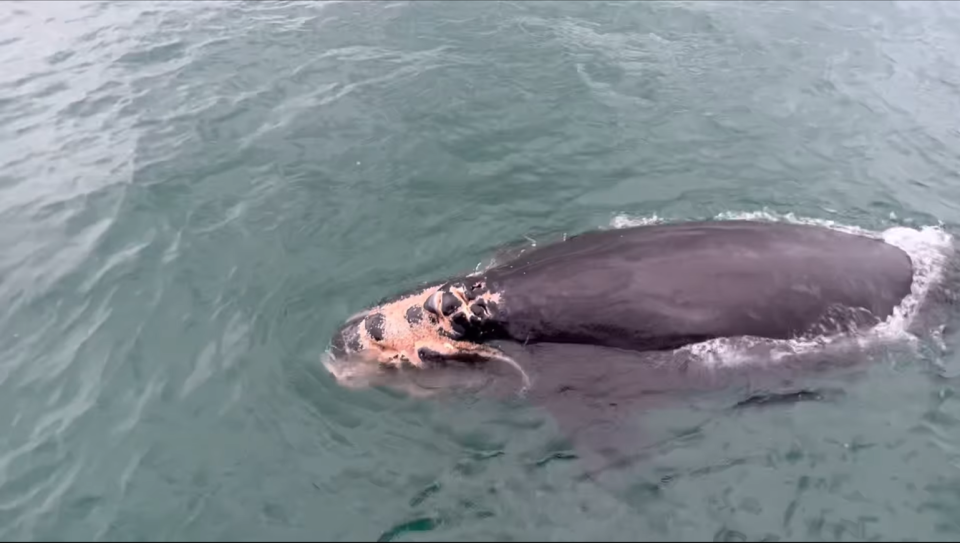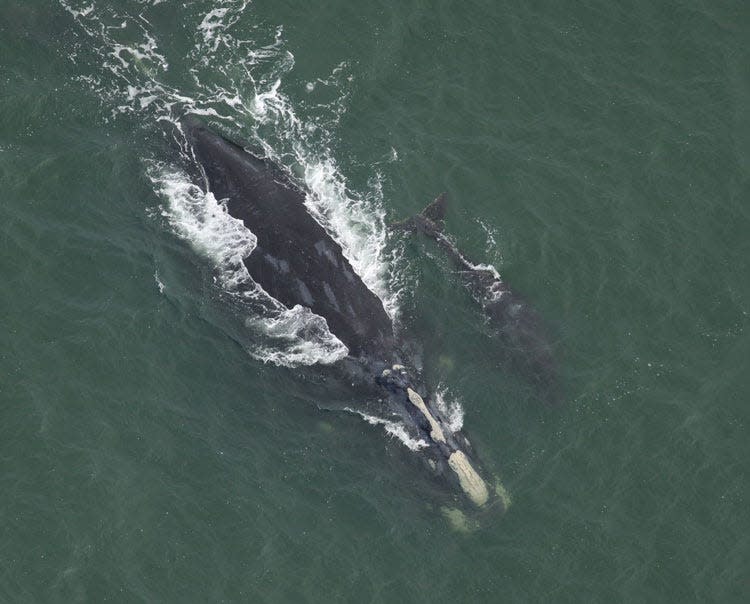'Devastating case': Endangered whale calf maimed by propeller stirs outrage across US
Whale advocacy groups reacted with concern and outrage Wednesday after federal officials announced a critically endangered right whale calf had been spotted off the South Carolina coast with injuries so severe it's likely to die.
North Atlantic right whales are one of the most endangered marine mammals in the world, with a population estimated at 356. Pregnant female right whales migrate from the waters off Canada and New England to the Southeastern United States during the winter to give birth. That requires them to navigate waters busy with ships, military vessels, fishing boats and pleasure craft.
The injured calf was first spotted off South Carolina with its mother, a whale nicknamed Juno, on Nov. 28. It was the first of nine calves spotted so far this season, stated the National Oceanic and Atmospheric Administration's Fisheries Service in the announcement.
Fishermen aboard a boat with Forever Hooked Charters out of Edisto Island, South Carolina, saw a blip pop up on the boat's radar, then when they slowed they saw a whale surface in the distance, said boat captain Scott Duncan. They stopped the boat off the Edisto River Inlet and the calf approached the boat. Excited to see the massive mama and her calf, they posted photo and videos of their encounter on Facebook, then shared the images with NOAA when someone reached out to them on Jan. 6.

What happened to the right whale calf?
The head and mouth of the newborn calf are gashed open with propeller wounds.
Biologists with the Georgia Department of Natural Resources stated the calf's injuries appear severe but "not fresh." In photos, the wounds are covered in cyamids, small crustaceans commonly found on whales. The injuries may impact this calf’s ability to nurse, the department stated.
The calf is the 14th right whale since 2008 to be struck by a vessel in U.S. waters with an injury that led either to a death or an injury from which the animal was not likely to survive, according to the New England Aquarium. Federal scientists have previously stated the death of even one right whale a year as the result of human causes jeopardizes the species' survival.
“This devastating case brings a heightened sense of urgency to address the significant challenges North Atlantic right whales are facing," said Amy Knowlton, senior scientist in the aquarium's Anderson Cabot Center for Ocean Life. "It is crucial to act now to implement enhanced regulations to protect this critically endangered species along the U.S. East Coast."
Boaters off the coast of Georgia, South Carolina and northeast Florida are being asked to report sightings of the injured calf to 877-942-5343 or the Coast Guard marine VHF channel 16, including time, location and any other details.
The injuries follow months of debate over proposed modifications to the agency's existing vessel speed rules to protect the right whales. The proposed changes would expand the size and time period for seasonal restricted speed zones, extend the restrictions to include most vessels measuring 35 to 65 feet in length, and implement mandatory speed restrictions in temporary speed zones enacted when whales are observed.
Read more: Saving endangered right whales pits advocates against lobstermen
What's the status of NOAA's proposed rule modification?
"While NOAA Fisheries anticipated taking action on the proposed rule to modify North Atlantic right whale vessel speed regulations in 2023, the rulemaking process remains underway," Lauren Gaches, with the agency's public affairs, stated Wednesday.
Advocacy groups slammed the Biden administration over the lengthy process to enact the changes to the speed restrictions, pointing out it has been over a year since the rule was proposed.
"Today we’re still waiting for the government to do what it knows needs to be done," said Gib Brogan, a campaign director for Oceana, an ocean advocacy group,
"Just weeks old, this calf offered hope to help rebuild a species on the edge of extinction due to human negligence," Brogan stated, also noting that two whales were found dead last year in the Southeast. "We don’t need any more morbid anniversaries, we need urgent action from the Biden administration to protect North Atlantic right whales."

A year ago, the administration denied an emergency petition by Defenders of Wildlife and others to set speed limits for vessels 35 feet and longer.
On Wednesday, Jane Davenport, a senior attorney with Defenders chided the administration for "inexplicably dragging its feet" in finalizing the rule modification.
The marine industry has protested NOAA's rule, calling it extreme. In an October news release, Jeff Angers, president of the Center for Sportfishing Policy, said "archaic vessel speed restrictions are not the best we can do to protect endangered whales."
"Technology is the answer, and the solutions are within reach," Angers stated in a news release from the National Marine Manufacturers Association.
On Tuesday, NOAA announced it is partnering with the non-profit MITRE Corporation, with $9.9 million in Inflation Reduction Act Funds, to develop technologies and engineering approaches related to whale detection, vessel strike avoidance and ropeless/on-demand fishing gear.
After talking with several biologists since his first encounter with the massive whales that day, which he first picked up on radar, Duncan, the charter boat captain offered a suggestion for federal officials. "I think a great solution for the government would be to help charter fishers to better equip their boats (with equipment) to help spot the whales," Duncan said. "We would love to help protect them."
Non-profits and agencies collaborate to fly aerial surveys to spot mother-calf pairs during the winter, but can often be grounded by high winds or choppy seas.
What other threats do the right whales face?
The animals also are threatened by entanglement with fishing gear and changing conditions in the oceans, including warmer temperatures fueled by climate change. Scientists say stress from entanglements and collisions are one reason the interval between female whales giving birth is more than twice as long as it used to be.
“There are so few right whales left that every death brings this species closer to extinction,” said Erica Fuller, a senior attorney for the Conservation Law Foundation.
Calves are roughly 14 feet when they are born.
Adults weigh up to 140,000 pounds and reach up to 52 feet in length.
They have a v-shaped blow spout.
Individual animals can be identified by patchy knobs of skin on their heads, called callosities, that are covered with whale lice.
On their feeding grounds off New England and Canada, right whales skim feed by swimming through dense patches of plankton.
This article originally appeared on USA TODAY: Whale calf maimed in shipping lanes stirs outrage, anger

